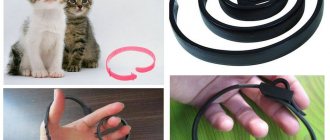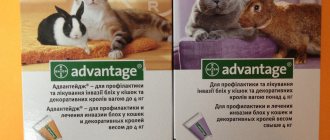How do flea and tick collars work?
The effect of the collar depends on the composition of the incoming substances. The instructions indicate that the drugs are aimed at preventing the appearance of blood-sucking insects, as well as their complete extermination. Products differ in the composition of substances and the basics of operation.
- Main component: herbs. They are impregnated with extracts of various herbs: grain, wormwood, geranium, eucalyptus, pine cones, which poison and repel harmful insects. These safe impregnation options are suitable for adult cats and young kittens.
- With insecticides. They are made of rubber, which has a specific smell. It contains various chemicals. Poisons destroy parasites on the animal’s fur within a radius of 0.5 m over a certain period of time.
- With ultrasound. The special wave spectrum is harmful to hematopoiesis. Ultrasonic devices are not used in our country due to their high cost.
- Plastic options. Their action is to repel parasites from the animal.
The most common type is insecticidal options (specially chemically prepared). They are not too expensive and cope with the task quite effectively - they have a negative effect on parasites. The main active ingredients are: fipronil (phenylpyrazole), diazinon, dimpilate and others. These elements do not have a harmful effect on adults.
How is destruction carried out? Vapors of toxic poisons are evenly distributed throughout the animal’s fur. At the same time, some chemicals kill adult insects and their larvae, while others repel harmful arthropods. In general, the active ingredients are not absorbed into the bloodstream, but remain on the surface of the epithelium.
Advantages and disadvantages
Benefits of using flea collars for cats:
- the most hygienic product;
- easy to use;
- efficiency is guaranteed;
- long-term protective effect;
- does not require large financial costs;
- chemicals do not settle on the skin;
- length adjustment.
Disadvantages of use:
- Some animals may have allergies;
- most products are not recommended for pregnant cats and young kittens (herbal or ultrasonic only);
- presence of an unpleasant odor;
- possible loss of hair on the neck;
In any case, you should not leave the animal without treatment. Even if the pet does not go outside and does not come into contact with stray animals, because the owner can bring the microscopic parasite to his home on his clothes.
Important! You should not buy too cheap fake analogues, which can be more harmful to the animal than parasitic creatures.
Attention! Insect parasites on wool are carriers of diseases dangerous to humans.
Advantages and disadvantages
When choosing a flea collar, you need to consider all the pros and cons of the accessory. Benefits include:
- versatility (used both for prevention and for getting rid of insects, you can choose the best option for an animal of any age);
- simplicity and ease of use (the collar is easy to put on and can be removed at any time);
- availability (available in all pet stores, very loyal pricing policy);
- safety (the active drug does not penetrate the cat’s blood);
- long lasting effect;
- the accessory looks attractive , and in addition it can be used as a sign by writing the owner’s phone number or address.
The main disadvantages include the following:
- insufficient effectiveness (the collar is good for prevention, but for getting rid of ticks the concentration of the active substance is not high enough);
- unpleasant odor (at first it causes anxiety for the animal, but after 7-10 days it practically disappears);
- the risk of an allergic reaction (substances with which the collar is impregnated can cause contact dermatitis in some animals);
- skin damage (the accessory can rub the delicate skin on the neck, this situation is especially common in representatives of hairless breeds, for example, Sphynxes).
If your cat is outdoors, wearing a collar can be a source of increased danger. For example, an animal may get caught on a branch or nail in a fence.
Features of flea collars
Of all the anti-parasitic agents, special anti-flea and tick collars for cats have gained the greatest popularity in use. They are convenient and easy to use, and if chosen correctly, they are effective and safe for the animal.
For kittens
Main features of the kitten accessory:
- the dosage of poison is designed for a small kitten;
- After the baby reaches the age of 2 months, it is possible to use a bio-collar, which does not contain poisons, but only repellent mixtures such as essential oils. Validity period – 4 months;
- from 6 months, collars with a special dose are used;
- Regular collars have been used on cats since they were one year old.
Pregnant and lactating cats
Features of collars for pregnant and lactating cats:
- do not contain poisons, but are biological collars;
- contains essential oils for repelling (for example, lavender).
General safety rules when using a flea and tick collar
Perhaps the main “requirement” is – do not skimp on your pet’s health! Cheap collars most often emit a strong odor, which will discharge the animal. There is no point in cutting off part of the collar, much less dividing it in half to use for two animals. The original length of the accessory is designed for the weight of the animal and the period of use indicated on the package. Inspect the packaging, there should be a diagram on it on how to put on and fasten the collar on the animal, the excess part is wrapped in a second layer.
Note! A safety collar is put on 7–10 days after treating the animal with drops and is used as an additional measure of protection. Only an accessory with a broad spectrum of action can provide complete protection, but it will not be safer or less allergenic than analog insecticides.
Monitor your pet's behavior; if the cat licks the collar, this may mean that it is irritated by the smell, the very presence of the accessory, or itching caused by skin irritation. High-quality collars are conditionally safe for licking, but on each package next to “it is possible” there is an inscription: “In case of poisoning, contact a veterinarian” and this is no pun.
Phosphoric acid contained in active agents can have a detrimental effect on the functioning of the gastrointestinal tract and metabolism. Collar allergies are common. The skin on the neck turns red, itches, the animal loses its hair and looks lethargic. The reaction does not occur to the collar itself, but to its active substance! The accessory should be removed from the animal without delay, and a milder action product should be chosen to replace it.
General rules:
- The collar is removed from the packaging, put on the animal and fixed so that 2 fingers fit freely between the strap and the animal’s neck.
- If the accessory is removed for a while, it is sealed (bag, cling film).
- The collar is replaced after the expiration date.
Owners who prefer to humanize everything that happens to animals tend to “test” collars on themselves. When putting an accessory on the wrist, the cat owner monitors the reaction of his own skin - this is wrong! The metabolism and skin type of cats and humans are very different; a component that is safe for humans can kill a cat. But it is still worth giving up a collar that caused an allergy in the owner for reasons of caring for your own health.
Note! Many veterinarians are opposed to collars due to the risk of poisoning and low effectiveness compared to drops.
How long should a cat wear a collar to get rid of fleas?
As a rule, the instructions for the collar itself indicate the age of the kitten at which the collar can be put on, after what time the collar begins to work and how long its effective action lasts.
The last time I bought a collar with the following parameters: the kitten must be at least 9 months old, the effect of the collar began in two to three weeks and the duration of action is written about six months, but in fact it looks like it lasts much longer. All deadlines have long passed, the cat goes out for a walk near the house every day, but no fleas are visible yet. It seems to me that the collar is probably still working for more than a year, or there are simply no more fleas in our area.
Little kittens are weak and delicate, so it is not recommended to put flea collars on them until they are 2 months old.
It is better to ensure that the mother cat is clean and free of fleas.
Starting from 2 months, a kitten can be put on a collar, but not one that is intended for adult cats, because they are impregnated with strong insecticidal preparations that are toxic to small kittens.
For them, collars are impregnated with more gentle bio-compositions - plant essential oils that repel fleas with their smell.
Before you put a collar on your kitten, you need to make sure that he doesn't have fleas. Otherwise, there will be no effect.
The validity period of such a collar is usually 4 months.
When your cat turns 6 months old, you can wear a flea collar with insecticidal substances, but also for kittens, with a lower concentration of chemicals.
It is fashionable to wear any anti-flea collars on an adult cat or a cat from 1 year of age. But, make sure that the coat is clean and free of fleas. Just in case, you can wash the animal with a special shampoo and only then put on a collar.
Now many different companies produce such collars, both expensive and cheaper.
The box always states how many months your pet can wear it while repelling fleas.
Usually 4 months . Then the smell weakens and disappears. You need to wear a fresh one.
Lately, you can often see a cat wearing a flea collar walking down the street. This stylish accessory has a very specific function - protecting the animal from external parasites. However, pet owners do not always have the correct understanding of how a flea collar for cats works. Awareness of this issue will allow you to avoid a lot of mistakes when using this means of protection.
Read in this article
Wearing rules
Many collars emit a specific unpleasant odor, so cats do not like wearing them around their necks. Basic tips for the correct use of collars:
- open the package;
- put the collar on in such a position that your fingers can be easily held between it and the animal’s neck;
- secure it with a special fastener;
- trim the excess length of the tape.
The instructions on the package or from the manufacturer indicate a maximum shelf life ranging from a few weeks to six months. It is best to replace it at least once every 2-3 months.
Important! The period of protection against fleas is 4 - 6 months, against ticks is much shorter - no more than 2 months.
Precautionary measures
Due to the fact that the collar contains toxic substances, it is necessary to take precautions when handling it:
- if the collar is ineffective and the pet shows signs of allergies, then an urgent need to change the manufacturer;
- you need to purchase those products that, according to reviews, are recommended as effective;
- use simultaneously with other drugs is prohibited;
- correct placement of the collar on the animal to prevent harmful substances from entering the food tract.
Approximate cost of anti-flea accessories
The cost of collars varies depending on the manufacturer. Imported analogues are priced at 500-800 rubles, depending on the duration of action. There are copies priced at 3,000 rubles.
Russian analogues are priced from 50 to 250 rubles, depending on the composition and duration of action.
It is not recommended to use cheap Chinese analogues. The active substances included in their composition have not been studied. This can negatively affect your pet's health.
Terms of use
As stated earlier, a cat flea collar is extremely easy to use. However, to be completely sure, you can usually easily find instructions with the points presented below in each package.
- Remove the collar from the packaging.
- Remove the plastic bridges.
- Stretch the collar slightly until it changes color slightly to a lighter color.
- Place the accessory on your pet's neck with a small margin, so that two fingers can fit freely.
- Trim off excess tape.
However, it is worth considering one nuance. If you have already discovered parasites in your pet’s fur, and in large quantities, you will have to first resort to other means. Drops are best for this. After about a week, the cat needs to be bathed and only then put on a collar.
Important. Do not use several methods of flea protection at once! Even between the uses of products that are similar in their principle of action (for example, flea spray and drops), several days should pass. Otherwise, it may have a bad effect on your pet's health.
Reviews from veterinarians and buyers
Svetlana, Voronezh . In the summer, while at the dacha, our pet interacted with street cats and picked up fleas. No matter how much we tried, we could not cope with the problem. The imported version of Bolfo came to the rescue. Although the price is high, the effect is 100%. They put it on once and forgot about it, although the cat still had the same lifestyle. I recommend.
Valentina, Saratov . We live in a private house. We got a cat. Naturally, he constantly walks outside and communicates with other animals. The problem of fleas is urgent. We purchased a Hartz collar. Forgot about the problem forever. Now we just change the collar every 4 months.
Ekaterina, Ekaterinburg . We bought a Bars collar. An allergy appeared, the area on the neck turned red and hair began to fall out. They urgently changed the manufacturer. We bought Bolfo. The allergy problem quickly disappeared. Everything is fine now. Thanks to the manufacturer.
A flea and tick collar for cats is an effective means of combating parasites, as the animal is provided with protection from several weeks to several months. You must always ensure that it is flexible. Otherwise, it may pose a threat to the cat, which, for example, clings to branches. For domestic cats, it is advisable to use a collar containing essential oils.
How and why a flea collar helps
By buying your pet a preventative anti-flea and tick collar for cats and putting it on, you can eliminate the threat to them from the following troubles.
- If the animal is already infected with parasites and suffers from their bites, then the adult bloodsuckers quickly leave the victim’s body due to the repellent effect.
- When a cat is walking and contact with homeless relatives is possible, the product will protect against those fleas that live on them, and they will not attack your cat or kittens.
- A flea collar for cats and outdoors, where owners often take their furry pets, will be a reliable shield against parasites. There he will protect the cat or kittens from tick attacks.
- The absence of blood-sucking pests on the pet’s body will significantly prevent infection with helminths, the eggs of which enter the pet’s body when a bloodsucker is accidentally ingested.
- In addition to these parasites, the product also works effectively against lice and ear mites.
Important! It is better to wear the product outside the home, because fleas leaving the pet can scatter around the house, hide in cracks and other places difficult for owners to reach, and then attack a person, choosing him as a food source. Even if you are sure that your pet is clean and there is not a single flea on it, it doesn’t hurt to be on the safe side.
To sum up, we can definitely admit that a cat collar against flea attacks works great, bringing additional bonuses to the pet’s health. To understand how such a high and long-lasting level of protection against parasites is ensured, you need to consider the principle by which the product works.










